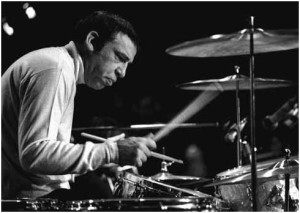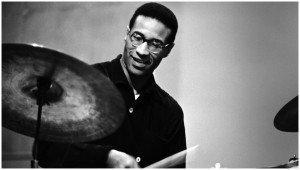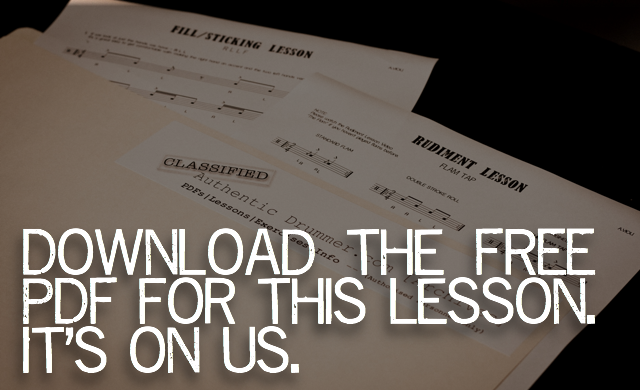 Jazz drumming is a massive subject. It takes years just to get through the basics. But you have to start somewhere and this short lesson is about just that.
Jazz drumming is a massive subject. It takes years just to get through the basics. But you have to start somewhere and this short lesson is about just that.
My goal here to clarify a basic Jazz pattern on the drums and then the steps to take to begin freeing up the left hand (and bass drum) to be able to “comp” or improvise patterns that compliment the music you’re playing to. The role of 2 and 4 is taken away from the snare drum (i.e. Rock drumming) and put onto the hi-hat. Combined with the standard Jazz ride pattern, this forms the ostinato (repeated pattern) and the base for playing Jazz on a drum set. The idea is that this pattern remains solid and steady while you use your left hand on the snare and your right foot on the bass drum to comp random and improvised ideas. The trouble is that your left hand won’t automatically play ball and will undoubtedly cause your ride cymbal pattern to change. This is where the subject of independence comes in. We need to practice exercises to allow the left hand go gain freedom to work independently of the right hand. This takes time and patience.

In the video, I go through some phrases on the snare drum that I think will help develop some basic independence and also makes for some more authentic sounding Jazz grooves. You’ll need to start slowly and evenly. Treat each exercise as a musical phrase and play with feel and dynamics.
There are many levels you can go to with this stuff. For example, on the PDF for download below, I have patterns A – G notated on the snare with the ride/hats and then with the bass drum. In the video, I only have time to demonstrate the snare drum variations but you should also practice these on the bass drum. Furthermore, another great idea to is play  quarter notes (crotchets) very softly on the bass drum under all the snare drum exercises. This is called feathering the bass drum and it common. You do want to keep it soft though as quarter notes is exactly what the bass player often plays and you don’t want to encroach on his territory. Something to remember.
quarter notes (crotchets) very softly on the bass drum under all the snare drum exercises. This is called feathering the bass drum and it common. You do want to keep it soft though as quarter notes is exactly what the bass player often plays and you don’t want to encroach on his territory. Something to remember.
Part 2 of this series will tackle some more advanced essentials I’ve found very useful in my learning and subsequent playing. Write in with your thoughts if you want to! Would love to hear from you.
Hope you enjoy the video.


Hi Adrian,
I was looking for a Jazz101 lesson, thanks to you I’ve ound what I was looking for !
I’m having biiiig difficulties with G, would you have some piece of advice to go through that one ?
Thanks a lot for the hard work.
Magalie
Hi Magalie,
Thanks heaps for the comment. Glad you’re getting something out of this! This is only the tip of the iceberg too don’t forget!
Letter G is not really natural to feel so understand the difficulty. My advice is to play it super super slow making absolutely sure that the ride cymbal and hi-hat don’t alter or shift. If you can make it feel good at a really slow tempo, that should give you the goods to speed it up a bit. Also bear in mind, you don’t have to play G as a full exercise all the time. You may just want to start by playing the first snare hit, moving to two etc. This is another option.
Stay in touch!
Really appreciate your video and the great tips you have on here, gonna be passing it on and using the ideas with my own students! Glad I found your videos, they are appreciated.
nice………….video i am a junior drummer.
thank you for the pdf notes……………..